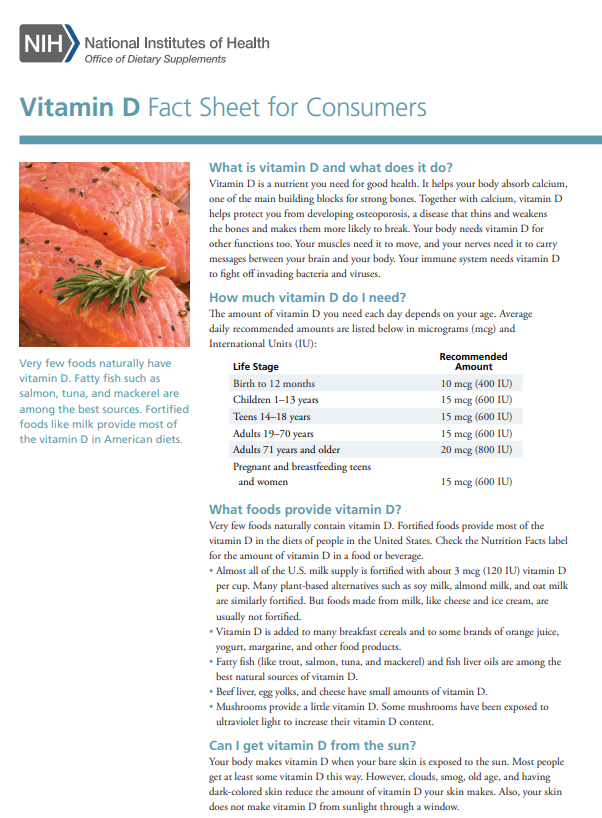Vitamin D
Key points about Vitamin D
- We need vitamin D for strong bones, teeth and muscles.
- Vitamin D is sometimes called the sunshine vitamin because we make it when the sun shines on our skin.
- It can also be found in some foods like fish and eggs.
- It can also be taken as a supplement.

Vitamin D is important for the absorption of calcium and phosphorus from your gut and for the functioning of calcium and phosphorous in your body. This helps your bones and teeth to stay healthy and your muscles to work well.
Most of your vitamin D is made when UVB rays from the sun fall on your skin. You also get a small amount of vitamin D from foods (eg, oily fish, liver and egg yolks). The vitamin D is then activated by your liver and kidneys.
Low levels of vitamin D cause problems with soft or easily broken bones, eg, rickets in children, and osteoporosis and osteomalacia (soft bone disease) in adults. Lack of vitamin D can cause deformities of teeth, lack of enamel and dental cavities.
Low vitamin D levels may also be linked to other health conditions, eg, colorectal cancer, cardiovascular disease, mental health and immune system problems, but the evidence isn't clear at this stage.
Vitamin D is measured in micrograms written as µg, so 5 µg/day means 5 micrograms per day. The amount you need depends on your age and stage of life:
- Infants to adults (1–50 years of age): 5 µg/day.
- Pregnant and breastfeeding people: 10 µg/day
- Adults (51–70 years of age): 10 µg/day. This is sometimes written as 400IU (international units)
- Older adults (70+ years of age): 15 µg/day.
If you don’t have enough vitamin D in your body it's called vitamin D deficiency.
Who is at higher risk of vitamin D deficiency?
You are at higher risk of vitamin D deficiency if you
- have dark skin
- have a condition that prevents you getting sun exposure, eg, a melanoma in the past
- wear clothing that covers your skin most of the time for cultural or religious reasons
- have a condition that impairs the absorption of vitamin D through your gut, eg, Crohn's disease or coeliac disease
- are of Māori, Pacific, African or Indian ethnicity
- live in southern regions of New Zealand (south of Nelson/Marlborough), which means you may experience short-lived vitamin D deficiency between the winter months of May and August
- are confined indoors, eg, due to occupation, disability, age or illness (especially older people).
When you're pregnant or breastfeeding
Vitamin D needs are higher during pregnancy and breastfeeding. It's important both for your own health and wellbeing and for your baby's development in pregnancy.
If you have low vitamin D levels, your baby is also at risk of having low vitamin D levels. This puts your baby at risk of complications, eg, abnormal bone growth, delayed physical development and rickets. Rickets is a condition that affects bone development in children. Rickets can cause bone pain, poor growth and deformities of the skeleton, such as bowed legs, curvature of the spine, and thickening of the ankles, wrists and knees. Children with rickets are also more likely to fracture their bones. Read more about rickets.

Image credit: Canva
Babies are also at higher risk of vitamin D deficiency but they shouldn't be exposed to direct sunlight. Read more about vitamin D supplements for babies.
If you don't have enough vitamin D you may not notice any symptoms at first, but if it's severe you may get:
- aches
- cramps
- pain in your muscles.
An ongoing lack of vitamin D can increase your risk of weak, brittle bones and osteoporosis.
If you're at higher risk of vitamin D deficiency your healthcare provider will likely prescribe a monthly supplement without needing a test. However, they may order a vitamin D blood test if you have symptoms of vitamin D deficiency.
The test isn't funded (except for people with very specific health conditions, eg, rickets) so if you want to have your vitamin D levels checked there will be a cost involved.
A test is generally not needed for monitoring your levels if you're taking vitamin D.
Vitamin D from the sun
The amount of sun each person needs varies a lot with the season, your age, your health needs, where you are and your skin type. Most people in Aotearoa New Zealand get enough vitamin D in the summer months because we have a lot of UVB exposure. It takes between about 6 minutes (for a fair skinned person in the north) and 20 minutes (for a dark skinned person in the south) with the sun on your face, hands and lower arms to get enough vitamin D for the day. UVB does not get through glass, so the sun needs to fall directly on your skin, not through a window.
You don’t need to go out into the sun especially to make vitamin D, most people will make enough just doing their daily activities.
Note: Sunscreen should always be used to prevent skin cancer, this won’t stop your body making vitamin D. Between September and April it's best to avoid going out between 10am and 4pm when UV radiation is highest.

Image credit: Canva
Vitamin D is stored in your body for up to 2 months, so your summer stores will get you part way through winter too. In winter it could take more than an hour of sun exposure to get enough vitamin for your daily needs. Between May and August it’s best to exercise outside during the middle of the day. Winter is also a good time to enjoy foods that have a higher vitamin D content.
Vitamin D from foods
Getting enough vitamin D from food alone is hard to achieve as not very many food contain, or are supplemented with, vitamin D in Aotearoa New Zealand. The best food sources of vitamin D are:
- oily fish, either freshly cooked or canned (eg, salmon, herring, mackerel, sardines)
- foods that have had vitamin D added (eg, margarine, some milks and yoghurts)
- full-fat milk and butter
- egg yolk.
Vitamin D supplements
Vitamin D supplements are not usually required unless you're at risk of vitamin D deficiency. Vitamin D is sometimes included in non-prescription multivitamin supplements. If you choose to take vitamin D supplements, 10 micrograms a day will be enough for most people.
Don't take more than 100 micrograms (4,000 IU) of vitamin D a day as it could be harmful. This applies to adults, including pregnant and breastfeeding women and the elderly, and children 11 to 17 years of age.
People at risk of vitamin D deficiency
If you're in a group at higher risk of vitamin D deficiency, talk to your doctor or nurse practitioner about vitamin D supplements. The vitamin D supplement available on prescription is a tablet called colecalciferol. Because vitamin D is stored well in your body it can usually be taken just once a month. Vitamin D supplements have been shown to help reduce falls and fractures in older people in residential care. Read more about vitamin D and falls.
Taking supplements under the care and advice of your doctor or nurse practitioner helps to make sure you're getting the full benefit. It also reduces the risk of harm that can occur from taking too much vitamin D. Taking too much vitamin D over a long period of time can cause too much calcium to build up in your body (hypercalcaemia). This can weaken your bones and damage your kidneys and heart.
Your doctor or pharmacist can also check for any interactions between supplements and other medicines you may be taking.
People at severe risk of vitamin D deficiency
Some people are at risk of more severe vitamin D deficiency, and need higher doses of vitamin D supplements (colecalciferol(external link)) because of having specific health conditions. Examples include:
- conditions where you don't absorb nutrients from your gut well, eg, Crohn's disease(external link) or coeliac disease(external link)
- chronic liver disease(external link)
- hypoparathyroidism.(external link)
In chronic kidney disease, damage to your kidneys affects the metabolism of vitamin D. People with severe kidney disease may require vitamin D supplements, eg, alfacalcidol (One alpha®) or calcitriol (Calcitriol-AFT®), and other supplements (eg, calcium).
Read more about vitamin D supplements for adults.
Eating and activity guidelines(external link) Health New Zealand | Te Whatu Ora
Consensus statement on vitamin D and sun exposure in New Zealand(external link) Cancer Society, ACC and Ministry of Health, NZ
Vitamin D(external link) Sunsmart, NZ
Understanding vitamin D levels and how to stay sun safe(external link) MoleMap, NZ, 2020
Resources
Vitamin D – factsheet [PDF, 235 KB] Refugee Health Network and Auckland District Health Board, NZ English [PDF, 235 KB], Amharic [PDF, 313 KB], Arabic [PDF, 366 KB], Burmese [PDF, 290 KB], Somali [PDF, 256 KB]
Vitamin D fact sheet for consumers(external link) NIH, US, 2021
References
- Sizar O, Khare S, Goyal A, Givler A. Vitamin D deficiency(external link) StatPearls, NIH, US, 2023
- Vitamin D and calcium supplementation in primary care – an update(external link) BPAC, NZ, 2016
- Vitamin D(external link) New Zealand Formulary
- Vitamin D supplementation – navigating the debate(external link) BPAC, NZ, 2011
- Vitamin D tests and deficiency(external link) Choosing Wisely, HQSC, NZ
- Vitamin D deficiency including osteomalacia and rickets(external link) Patient Info Professional, UK, 2021
- Vitamin D supplementation(external link) Auckland Region HealthPathways, NZ, 2017
Clinical resources
25-hydroxy vitamin D testing for funded requests(external link)
Labtests Pathology, NZ, 2019 Vitamin D deficiency - investigation and management(external link) Starship Clinical Guidelines, NZ, 2017
Vitamin D and calcium supplementation in primary care: an update(external link) BPAC, NZ, 2016
Consensus statement on vitamin D and sun exposure in New Zealand(external link) Ministry of Health, NZ, 2012
See our page Skin cancer for healthcare providers
Vitamin D and COVID-19
There is some evidence of an association between vitamin D deficiency and increased severity of COVID-19. Ensure going into winter that people who are likely to have low vitamin D levels receive supplementation. This includes older people who are frail, housebound or living in residential care, people with dark skin pigmentation or people with obesity, chronic kidney disease, liver failure or another medical condition that affects vitamin D metabolism. There is no evidence it is effective in treating COVID-19.
Source: Griffin G, Hewison M, Hopkin J et al. Vitamin D and COVID-19: evidence and recommendations for supplementation(external link) Royal Society Open Science. Dec 2020; 7(12).
Brochures

NIH, US, 2021
Credits: Healthify Editorial Team. Healthify is brought to you by Health Navigator Charitable Trust.
Reviewed by: Dr Emma Dunning, Clinical Editor and Advisor
Last reviewed:






